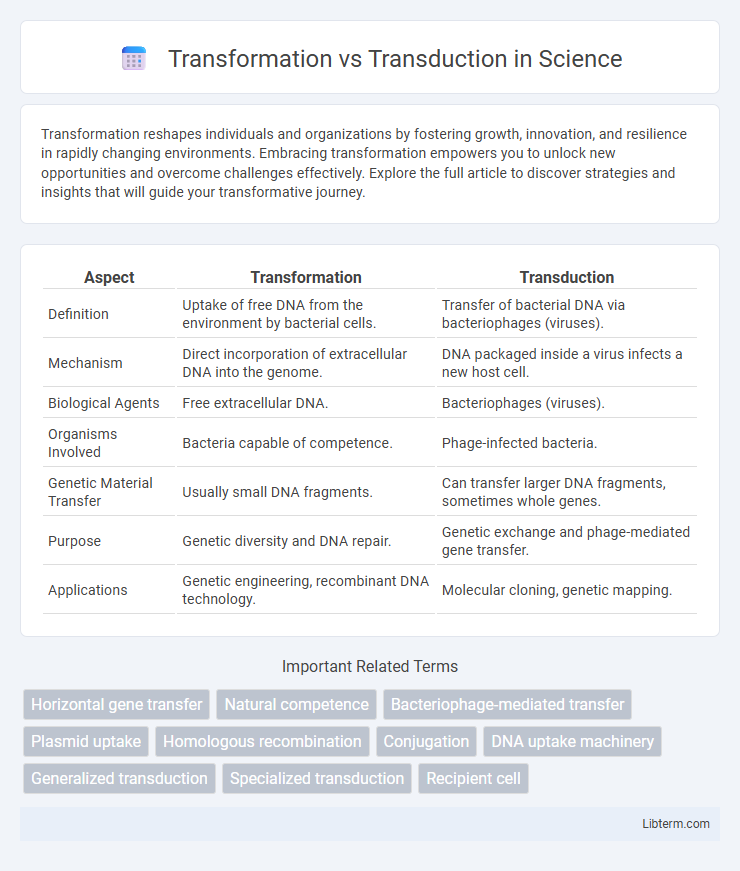Transformation reshapes individuals and organizations by fostering growth, innovation, and resilience in rapidly changing environments. Embracing transformation empowers you to unlock new opportunities and overcome challenges effectively. Explore the full article to discover strategies and insights that will guide your transformative journey.
Table of Comparison
| Aspect | Transformation | Transduction |
|---|---|---|
| Definition | Uptake of free DNA from the environment by bacterial cells. | Transfer of bacterial DNA via bacteriophages (viruses). |
| Mechanism | Direct incorporation of extracellular DNA into the genome. | DNA packaged inside a virus infects a new host cell. |
| Biological Agents | Free extracellular DNA. | Bacteriophages (viruses). |
| Organisms Involved | Bacteria capable of competence. | Phage-infected bacteria. |
| Genetic Material Transfer | Usually small DNA fragments. | Can transfer larger DNA fragments, sometimes whole genes. |
| Purpose | Genetic diversity and DNA repair. | Genetic exchange and phage-mediated gene transfer. |
| Applications | Genetic engineering, recombinant DNA technology. | Molecular cloning, genetic mapping. |
Understanding Transformation and Transduction
Transformation involves the uptake and incorporation of free DNA fragments from the environment into a bacterial genome, enabling genetic variation without the need for cell-to-cell contact. Transduction is the process where bacteriophages transfer genetic material between bacteria by packaging host DNA during viral replication, facilitating horizontal gene transfer. Both mechanisms play critical roles in bacterial evolution, antibiotic resistance, and genetic diversity by enabling the exchange of genetic traits across populations.
Key Differences Between Transformation and Transduction
Transformation involves the uptake of naked DNA fragments from the environment by a bacterial cell, enabling genetic changes without requiring a viral vector. Transduction, in contrast, is the process where bacterial DNA is transferred from one bacterium to another via bacteriophages, utilizing a virus as a carrier. Key differences include the source of DNA (environmental in transformation vs. virus-mediated in transduction) and the mechanisms of genetic material delivery.
Mechanisms of Genetic Exchange: Transformation
Transformation is a mechanism of genetic exchange in bacteria where naked DNA fragments from the environment are directly taken up and incorporated into the recipient cell's genome. This process involves the binding of extracellular DNA to the cell surface, followed by its uptake through specialized membrane proteins and integration via homologous recombination. Transformation enhances genetic diversity, facilitating the acquisition of new traits such as antibiotic resistance or metabolic capabilities.
Mechanisms of Genetic Exchange: Transduction
Transduction is a mechanism of genetic exchange in bacteria where bacteriophages transfer DNA from one host cell to another. This process involves the packaging of host bacterial DNA into phage particles during viral replication, facilitating horizontal gene transfer. Transduction contributes to genetic diversity and the spread of traits such as antibiotic resistance among bacterial populations.
Historical Significance in Molecular Biology
Transformation, first demonstrated by Frederick Griffith in 1928, revealed the ability of bacteria to uptake genetic material from their environment, laying the foundation for understanding horizontal gene transfer. Transduction, discovered in the 1950s through the work of Norton Zinder and Joshua Lederberg, highlighted bacteriophages as vectors for gene transfer between bacteria, expanding the comprehension of viral roles in genetic recombination. Both processes significantly advanced molecular biology by elucidating mechanisms of genetic diversity and horizontal gene transfer, shaping modern genetic engineering techniques.
Applications in Biotechnology and Genetic Engineering
Transformation involves the uptake of naked DNA by bacterial cells, widely applied in genetic engineering for cloning and protein expression, enabling the introduction of recombinant plasmids into host cells. Transduction uses bacteriophages to transfer genetic material between bacteria, serving as a precise tool for gene mapping, mutagenesis, and phage display in biotechnology. Both methods facilitate genetic modification and are critical for developing genetically engineered organisms, synthetic biology, and therapeutic gene delivery systems.
Factors Influencing Transformation and Transduction
Factors influencing transformation include the physiological state of the bacterial cells, environmental conditions such as temperature and ion concentration, and the presence of specific uptake sequences in the DNA. Transduction efficiency depends on the type of bacteriophage, the host bacterial strain, and the stage of the phage life cycle during DNA transfer. Both processes are also affected by the genetic compatibility between donor DNA and recipient cells, as well as external stress factors that may induce competence or phage activation.
Advantages and Limitations of Each Method
Transformation enables direct uptake of naked DNA into bacterial cells, offering simplicity and efficiency for genetic studies, yet it is limited by species specificity and lower efficiency in certain strains. Transduction uses bacteriophages to transfer DNA, providing high specificity and the ability to mobilize large DNA fragments, but the method depends on suitable phage-host systems and can introduce phage DNA contamination. Both techniques are essential tools in molecular biology, with transformation favored for ease and speed, while transduction excels in targeted genetic exchange and versatility in complex genetic manipulations.
Real-World Examples in Microbial Genetics
Transformation in microbial genetics involves the uptake of naked DNA fragments from the environment, as seen in Streptococcus pneumoniae acquiring antibiotic resistance genes. Transduction, mediated by bacteriophages, transfers genetic material between bacteria, exemplified by Salmonella phages transmitting toxin-encoding genes. These mechanisms contribute significantly to bacterial evolution and genetic diversity in natural microbial communities.
Future Perspectives in Gene Transfer Research
Transformation and transduction are pivotal gene transfer mechanisms with distinct future research trajectories in gene therapy and synthetic biology. Transformation, relying on the uptake of free DNA, offers promising advancements in bacterial genome editing, bioengineering, and antibiotic resistance studies through enhanced competence systems. Transduction, mediated by bacteriophages, holds significant potential for targeted gene delivery, novel viral vector development, and precision microbiome engineering, driving innovation in personalized medicine and environmental biotechnology.
Transformation Infographic

 libterm.com
libterm.com